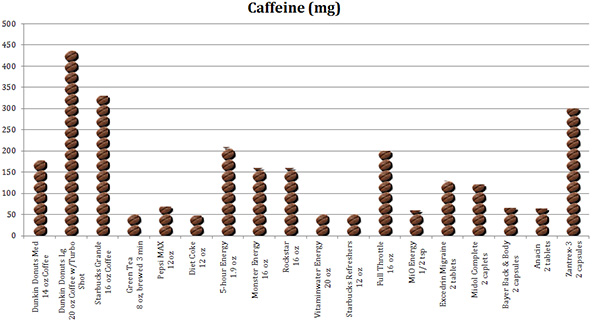How Much Caffeine is Really in Your Cup?
 Caffeine formula photo via Shutterstock
Caffeine formula photo via Shutterstock
When you’re sleep-deprived, stressed, and in need of help to get through the day, what do you do? Grab a large Dunkin’, and perhaps add a “turbo shot” for an extra boost? Or pick up an energy drink or shot from the nearest convenience store? You can even grab yourself a nostalgic, Ghostbusters themed energy drink produced by the Woburn-based novelty company Boston America. The options are endless. However, with all the recent deaths surrounding products like 5-Hour Energy and Monster Energy drinks, it’s important to know that not all caffeinated drinks are created equal. So what makes some harmless and others downright dangerous?
Caffeine is the most commonly used energy-booster, found naturally in coffee, tea, cola, guarana, and mate. When consumed, it stimulates the central nervous system (CNS), heart, muscles, and the centers that control blood pressure. When used moderately (about 300 mg per day) it can result in improved concentration and focus, reduce fatigue and for some, it can improve athletic performance. If caffeine is used heavily (more than 500 to 600 mg a day), or by those who are particularly sensitive to caffeine, it can send the central nervous system into overdrive and result in negative effects like insomnia, nervousness, restlessness, irritability, stomach upset, fast heartbeat, and muscle tremors.
One challenge is that not all products require caffeine levels to be listed in the label, particularly if that product is categorized as a supplement, like many of the energy shots available today. Another challenge is that caffeine is also found in unexpected places like over the counter pain medications, diet pills, and cold medicines. It’s also more concentrated in the popular ingredient guarana, a seed that has roughly twice the amount of caffeine as a coffee bean. Overall, it takes no more than one medium Dunkin’ Donuts coffee and a dose of Excedrin Migraine to reach the recommended “moderate limit” intake of 300 mg of caffeine a day.
To sort through all of this, I’ve done some digging and created a chart of a sampling of sources and relative amounts of caffeine found on the market. Make note of the serving size and how that compares to the recommendations. The caffeine found in energy drinks may not look excessive, but can be dangerous when combined with other stimulants often found in these kinds of drinks.

When energy drinks are combined with alcohol or drugs, the effects can be especially hazardous. In fact, a newly published government report shows a sharp increase in the number of emergency room visits involving energy drinks between 2005 (1,128 visits) and 2008 and 2009 (16,053 and 13,114 visits, respectively). Approximately half of these visits (52 percent) were made by patients between the ages of 18 to 25 and involved combinations of energy drinks with alcohol or other drugs.
It is important to note that everyone reacts differently to caffeine. For example, children metabolize caffeine faster than adults, and sensitivity can increase as we age. Some people can drink a whole pot of coffee and hardly feel a buzz while others experience sleep disturbances, anxiety, or heart palpitations. If you experience negative effects after consuming caffeine, or are pregnant, breastfeeding, at risk for osteoporosis, or have a heart or other medical condition, you may want to rethink your habit. Whatever your choice, caffeine is only a quick fix, because nothing beats a good nights’ sleep.


